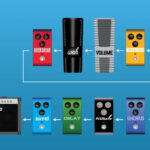It’s a sound no guitar player ever wants to hear – the sickening crack of wood giving way, followed by the sight of their beloved instrument with a broken neck. How does this happen? Is it just bad luck, or is there more to it? On guitars with angled headstocks, like the iconic Gibson Les Paul and SG, a broken headstock can sometimes seem almost inevitable. You might even call it a design vulnerability.
The weak point lies where the headstock angles back from the neck. This area is inherently weaker due to several factors. Firstly, the wood grain direction at this angle makes it more susceptible to stress. Secondly, it’s often the thinnest part of the entire neck. Adding to this inherent weakness, many guitars have a channel routed in this very area to allow access to the truss rod, the adjustable rod that controls neck relief. As you can see in the image of a Les Paul neck, the truss rod cavity removes a significant amount of wood, leaving very little material to withstand impacts or string tension. This combination of factors creates a perfect storm for headstock breaks.
Guitar manufacturers are well aware of this potential problem and employ various strategies to mitigate it. Some use multi-ply necks, constructed from layers of wood laminated together for increased strength. Others relocate the truss rod access point or reduce the size of the access channel. Scarfed headstocks, where the headstock is joined to the neck at an angle rather than being carved from a single piece of wood, are another approach. However, perhaps the most common attempt to reinforce this vulnerable area is the volute. A volute is a small, carved bulge at the neck-headstock joint, designed to add strength and prevent breakage – or perhaps more accurately, to lessen the inherent weakness.
Gibson, famous for their angled headstock designs, have a somewhat inconsistent history with volutes. While they introduced volutes on many models in the late 1960s as a strengthening measure, they later phased them out again. Modern Gibson guitars often lack a volute, leaving them more vulnerable. While any guitar with an angled headstock can be susceptible to breakage, Gibson guitars, particularly SGs and Les Pauls, are statistically over-represented in guitar repair shops for headstock repairs. In fact, it’s a common joke amongst guitar repair technicians that if Gibson ever truly solved this headstock issue, a significant portion of their repair income would vanish!
My Guitar Neck is Broken! What Now?
Discovering a crack or break in your guitar neck can be disheartening, but it’s crucial to remember: don’t panic. In almost every case, a Broken Guitar neck is repairable. Here’s what you should do immediately:
- If the headstock is still partially attached: If the headstock is cracked but still connected to the neck (often held together by the headstock veneer), the first step is to gently loosen the strings. Reduce the tension on the neck as much as possible without completely removing the strings. Carefully place the guitar in its case and take it to a qualified guitar repair technician as soon as possible.
- If the headstock is cracked but not fully broken: Follow the same procedure as above. Loosen the strings, case the guitar, and seek professional repair. Even a seemingly minor crack can worsen quickly under string tension.
- If the headstock is completely detached: If the headstock has completely broken off, carefully wrap it in something protective like a soft cloth, bag, or newspaper. Handle it gently, trying not to disturb or further damage any splintered wood at the break. Collect any loose splinters you can find and place them in a small bag – these pieces can be crucial for a seamless repair.
- Do not attempt to glue the headstock back yourself. Resist the urge to immediately apply glue and try to reattach the headstock. A proper repair requires careful examination of the break, cleaning of any loose wood or debris, and precise alignment and clamping. Attempting a DIY repair can complicate the process and potentially weaken the joint further.
- Gather any loose splinters. As mentioned, collect any wood splinters that have broken off and keep them safe. These fragments are like puzzle pieces and can significantly aid in achieving a strong and clean repair.
The Importance of a Proper Guitar Neck Repair
The initial repair of a broken guitar neck is paramount. A poorly executed repair dramatically increases the likelihood of the neck breaking again at the same point. Even normal string tension can be enough to pull apart a weakly repaired break. Furthermore, repairing a previous, inadequate repair is significantly more complex, time-consuming, and often requires more invasive procedures – not to mention, it will likely be more expensive.
The key takeaway? Prevention is always better than cure – try your best to avoid dropping or knocking your guitar! However, if the unfortunate happens and you do break your guitar neck, ensure it’s repaired correctly the first time by a skilled luthier or guitar repair technician.
Don’t hesitate to discuss the repair process with your chosen technician. A reputable repair person should be happy to explain their approach and the materials they plan to use. The choice of glue, for instance, is critical. For most headstock repairs, hot hide glue or aliphatic resin (wood glue) are the preferred adhesives. If a repairer immediately suggests using epoxy, it’s wise to inquire why. While epoxy has its place in certain guitar repairs, it’s not typically the first choice for headstock breaks due to its properties. While incredibly strong, epoxy can be less effective at penetrating fine cracks compared to hide glue or aliphatic resin. Choosing the right adhesive and employing proper clamping techniques are essential for a durable and long-lasting guitar neck repair.

